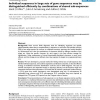Free Online Productivity Tools
i2Speak
i2Symbol
i2OCR
iTex2Img
iWeb2Print
iWeb2Shot
i2Type
iPdf2Split
iPdf2Merge
i2Bopomofo
i2Arabic
i2Style
i2Image
i2PDF
iLatex2Rtf
Sci2ools
BMCBI
2005
2005
Individual sequences in large sets of gene sequences may be distinguished efficiently by combinations of shared sub-sequences
Background: Most current DNA diagnostic tests for identifying organisms use specific oligonucleotide probes that are complementary in sequence to, and hence only hybridise with the DNA of one target species. By contrast, in traditional taxonomy, specimens are usually identified by 'dichotomous keys' that use combinations of characters shared by different members of the target set. Using one specific character for each target is the least efficient strategy for identification. Using combinations of shared bisectionally-distributed characters is much more efficient, and this strategy is most efficient when they separate the targets in a progressively binary way. Results: We have developed a practical method for finding minimal sets of sub-sequences that identify individual sequences, and could be targeted by combinations of probes, so that the efficient strategy of traditional taxonomic identification could be used in DNA diagnosis. The sizes of minimal sub-sequence sets depen...
| Added | 15 Dec 2010 |
| Updated | 15 Dec 2010 |
| Type | Journal |
| Year | 2005 |
| Where | BMCBI |
| Authors | Mark J. Gibbs, John S. Armstrong, Adrian J. Gibbs |
Comments (0)

